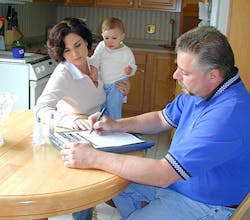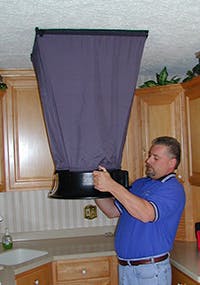Think back to your favorite HVAC system sale. It was kind of magical, right? Have you been able to repeat that magic over and over again? If not, it’s because you haven’t figured out what made that sale work so well. If you don’t figure that out, you won’t be able to repeat that success in the future. Let's take a look at a few principles that, if applied, can skyrocket your closing rates and take you back to that magic feeling you had after your favorite “killer” sale.
Delight Your Customer
The great Jim Norris, past executive vice president of the Air Conditioning Contractors of America (ACCA), who passed away last month, once gave a talk entitled: “Delight Your Customers!” Jim described the typical HVAC sales call where a salesperson did little more than push their brand of box to replace existing equipment.
In his scenario, one salesperson after another marched through this customer’s home proclaiming their brand of box was better than the next. The most effective tool in their arsenal was the manufacture’s glossy advertising brochures. Believing the lowest price would lock in the business, each was willing to undercut price and quality to win the bid. The closing rate of this type of sale was about one in five or 20%.
Then Jim contrasted that typical scenario to a sales person with a closing rate of 80%. This salesperson was successful on four out of five sales calls. As the title of his talk described, this salesperson found ways to delight his customer.
What was absent from this this second scenario was any discussion about equipment brand, rated efficiency, or price … until the customer felt confident enough in the salesperson to buy.
The entire conversation centered on customer needs and wants, comfort in the home, and an educational process that empowered the customer to confidently make a decision based on new knowledge received from the salesperson.
Bottom line of Jim’s talk – you should focus on the needs of the customer, not the wants of the salesperson. Because of this slight adjustment in approach, the customer became delighted to do business with this salesperson. The salesperson helped that customer to feel they made the right decision from the beginning of the conversation.
Teach, Don’t Sell
In my twenties I was the sales manager for a large real estate office. From time to time we’d bring in a great sales trainer named Tommy Hopkins. He would provide a day of training, pump up our salespeople on his Mountain Dew, and then they’d go out and sell like crazy. He taught principles like assumptive closes, handing the customer your pen when it was time to sign on the dotted line, and cool things to say that would get anyone to buy anything.
One day in the men’s room, Tommy asked me if I used “his stuff” when I was selling. After a few minutes of beating around the bush I admitted I didn’t. I was relieved that he didn’t get mad at me, but Tommy then asked what I did that made me so successful.
I took him in my office and showed him a little flip chart I created and used on sales calls. The chart showed customers what I would do, what my competitor should do, and what the customer needed to do when buying or selling a piece of property. In addition to the chart, I told Tommy that I taught customers what normally went wrong in a real estate transaction and what we could do to prevent those problems from occurring.
Tommy smiled and said “In 30 years, I’ll be able to teach people how to sell that way, but right now, that’s too advanced. But keep it up, son. Your principles are correct.”
Well, more than 30 years have passed and both customers and sales techniques have progressed a lot. Educating your customer is a timeless act of service where both of you will consistently win big.
Learn to teach your customers what they need to know to make good decisions. Educate them about the possible challenges of upgrading their system and assure them you care enough and have the know-how to satisfy their needs.
When you learn to teach your customer, in simple language, using examples they can understand, very rarely will you leave a home without securing the sale.
For example, I just got off the phone to verify that my brother, Brad Falke, who sells for an HVAC contracting company, has a closing rate averaging near 90 percent over the last decade. People say he is lucky, but in reality he’s just a terrific teacher; more concerned about helping his customers understand what they need, than he is worried about getting the sale. With a 90% closing rate, would you be worried?
Un-level the Playing Field
Salespeople who only sell replacement boxes (or equipment) for the lowest price harmonize together in their cry of unfair when they lose a sale. Basically, it’s the only way they can justify their lack of success. They are part of a culture driven by their manufacturer’s goal for ever-increasing market share, and these salespeople fear to offer customers custom products outside the box.
Who says competition has to be fair?
Successful salespeople who delight and educate want their customers to be knowledgeable so they can make good decisions. By doing this, they “un-level” the playing field on every sales call.
With knowledge, professionalism, a listening ear, originality, and creativity, they get almost every job because their customers choose to dismiss others from the playing field.
Give Your Customer Something to Do
What if you could involve your customers in discovering what they really want during the sales process? What if you could help them “see” why their system failed? What if, by teaching them to measure airflow in their home office, you could help them find the cause of discomfort in that room? What of you could show them their system’s blood pressure is 230 over 170?
You can do this by having them measure a few airflows and pressures. You set up the instruments and test. Tell the customer in advance the required measurement specification, and then watch carefully as they discover what they need in addition to equipment replacement.
By allowing your customers to discover what caused their system to fail, you’ll both win. And by doing this, you will have no real competition in the marketplace.
Rob “Doc” Falke serves the industry as president of National Comfort Institute an HVAC based training company and membership organization. If you're an HVAC contractor or technician interested in a free procedure to measure static pressure and convert air pressure to blood pressure, contact Doc at [email protected] or call him at 800-633-7058. Go to NCI’s website at nationalcomfortinstitute.com for free information, articles, and downloads.
About the Author
Rob 'Doc' Falke
President
Rob “Doc” Falke serves the industry as president of National Comfort Institute an HVAC-based training company and membership organization. If you're an HVAC contractor or technician interested in a building pressure measurement procedure, contact Doc at [email protected] or call him at 800-633-7058. Go to NCI’s website at NationalComfortInstitute.com for free information, articles and downloads.


